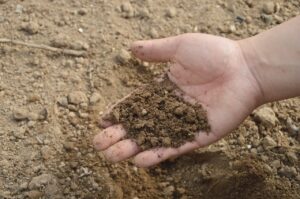What is the Role that Magnesium Plays in the Soil?
Soil health is essential for gardening, farming, and robust plant growth. Healthy soil provides plants with necessary nutrients to thrive. Magnesium, a key mineral, is crucial for plant development as it forms the core of chlorophyll, the green pigment vital for photosynthesis. Additionally, magnesium activates plant enzymes that transform nutrients into accessible forms. In this blog post, we’ll delve into magnesium’s critical role in soil health, its impact on plant growth, and how to recognize magnesium deficiency. Discover the indispensable role magnesium plays in ensuring soil health!
1. Understanding the Role of Magnesium in Soil Health
Understanding the role of magnesium in soil health is key to appreciating its importance in the broader context of soil composition and fertility. As a vital macronutrient, magnesium significantly influences various biochemical processes within the soil ecosystem. Crucially, it forms the core of chlorophyll, the pigment essential for photosynthesis, which allows plants to transform sunlight into energy and sustain growth. Insufficient magnesium leads to stunted growth, yellow leaves, and a lack of vigor in plants.
Additionally, magnesium activates enzymes crucial for plant metabolism, facilitating important reactions like nutrient uptake, protein synthesis, and carbohydrate metabolism. Inadequate magnesium can disrupt these processes, causing nutrient deficiencies and poor plant health. Beyond its direct effects on plant health, magnesium enhances soil structure and nutrient availability. It stabilizes soil electrical charges, preventing compaction and improving water infiltration and root growth. Moreover, magnesium helps maintain optimal soil pH, acting as a buffer against acidity and ensuring that essential nutrients such as phosphorus, potassium, and calcium are available for plant uptake.
In essence, magnesium is indispensable for soil health and plant vitality. Its role in chlorophyll synthesis, enzyme activation, soil structure enhancement, and pH regulation underscores its critical importance in promoting robust plant growth and fertility. By recognizing and managing magnesium levels in the soil, farmers and gardeners can nurture healthier crops and foster sustainable agricultural practices.
2. The Importance of Magnesium for Plant Growth and Development
Magnesium, often dubbed the “forgotten nutrient,” is crucial for optimal plant growth and development. This essential mineral supports numerous physiological processes, including photosynthesis and enzyme activation, through a range of biochemical reactions in plants.
A key function of magnesium is in chlorophyll synthesis. Chlorophyll, the green pigment essential for photosynthesis, depends on magnesium for its formation. Insufficient magnesium often leads to yellowing or interveinal chlorosis, where leaves turn yellow between green veins, signaling a deficiency that affects plant health and productivity.
Beyond chlorophyll production, magnesium activates enzymes critical for metabolizing carbohydrates, synthesizing proteins, and absorbing nutrients. It helps convert phosphorus into usable forms, facilitating energy transfer within the plant and influencing the uptake of other vital nutrients like nitrogen, potassium, and calcium.
To promote healthy plant growth, maintaining optimal magnesium levels in the soil is essential. Since different plant species have varied magnesium needs, soil tests are valuable for assessing nutrient availability and determining supplementation needs.
To ensure adequate soil magnesium, incorporating organic amendments such as compost or manure is effective. Additionally, applying magnesium-based fertilizers can correct deficiencies. However, it’s crucial to avoid excessive magnesium, which can cause nutrient imbalances and inhibit growth.
In conclusion, magnesium’s role in soil health is indispensable for fostering plant growth and development. From supporting chlorophyll synthesis to activating essential enzymes, magnesium’s contributions are vital. By managing soil magnesium levels effectively and addressing deficiencies promptly, gardeners and farmers can enhance crop potential and improve overall soil fertility.
3. Common signs of Magnesium Deficiency in Plants
Magnesium is essential for plant health and growth, yet deficiencies in soil are common and can drastically affect plant vitality and productivity. Recognizing signs of magnesium deficiency is crucial for gardeners and farmers to ensure their plants thrive.
One of the clearest signs of magnesium deficiency is the yellowing of leaves, particularly older ones. This yellowing often begins at the leaf edges and moves inward, forming a green V-shaped pattern at the base, a condition known as interveinal chlorosis. Additionally, magnesium-deficient plants may show stunted growth, reduced vigor, and brittle leaves, which may lead to weakened, wilted plants with underdeveloped flowers and fruits.
Magnesium deficiency also compromises a plant’s ability to absorb and utilize other essential nutrients, potentially causing further nutrient imbalances. Identifying these signs is crucial for correcting soil health and promoting optimal plant development.
To address these issues, gardeners and farmers can enhance soil magnesium through magnesium-rich fertilizers or by adding organic materials high in magnesium. Maintaining adequate magnesium levels is key to healthy plant growth, improved crop yields, and robust soil fertility. By actively managing magnesium deficiencies, we can ensure vigorous plant growth and abundant harvests.
4. The Impact of Magnesium Deficiency on Crop Yields
Magnesium is vital for plant growth, essential for maintaining soil health, and crucial for maximizing crop yields. Its deficiency can severely impact agricultural productivity. When crops lack magnesium, they often display chlorosis—yellow leaves with green veins—stunting growth and reducing vigor. Severe deficiencies may cause brown or necrotic spots on leaves, further impairing photosynthesis and the plant’s overall health.
Beyond affecting appearance, magnesium deficiency hampers vital plant functions. It’s a key component of chlorophyll, necessary for converting sunlight into energy through photosynthesis. Insufficient magnesium curtails this process, diminishing the plant’s energy production and crop productivity. Additionally, a lack of magnesium disrupts the uptake and metabolism of other critical nutrients, including nitrogen, phosphorus, and potassium. This disruption can prevent plants from accessing and efficiently using these nutrients, even if they are abundant in the soil.
To combat the adverse effects of magnesium deficiency, farmers and gardeners should regularly assess and maintain soil magnesium levels through soil testing. This identifies deficiencies and informs the application of magnesium-rich fertilizers or amendments. Proactively managing soil magnesium ensures healthier plants, enhanced productivity, and sustainable farming. Adequate soil magnesium is key to thriving crops and bountiful harvests.
5. Sources of Magnesium in Soil
Magnesium is crucial for soil health and vital for plant growth and development. For farmers and gardeners aiming to enhance soil fertility, understanding magnesium sources is key. One primary source is the weathering of magnesium-rich rocks like dolomite and magnesite, which slowly release magnesium into the soil, replenishing available nutrients for plants.
 Organic matter decomposition also contributes significantly to soil magnesium. As plant residues, animal manure, and compost break down, they release magnesium and other nutrients, enhancing soil structure and fertility. Additionally, magnesium may be present in irrigation water, depending on the source and region, contributing further to soil magnesium levels.
Organic matter decomposition also contributes significantly to soil magnesium. As plant residues, animal manure, and compost break down, they release magnesium and other nutrients, enhancing soil structure and fertility. Additionally, magnesium may be present in irrigation water, depending on the source and region, contributing further to soil magnesium levels.
Moreover, using magnesium-containing fertilizers, such as magnesium sulfate (Epsom salt) or dolomitic lime, is an effective way to supplement magnesium in deficient soils. Understanding these magnesium sources is essential for maintaining soil fertility and promoting robust plant growth. Regular soil testing can identify magnesium levels, guiding appropriate soil management to ensure plants receive optimal magnesium.
6. How to Test Soil for Magnesium Levels
Testing soil for magnesium levels is essential to understanding soil health and fertility. Magnesium is crucial for chlorophyll production, enzyme activation, and plant growth. Insufficient magnesium can cause stunted growth, leaf yellowing, and lower yields.
Several methods are available for assessing soil magnesium. A common approach is using a soil testing kit, which includes chemical reagents to measure magnesium. These kits are user-friendly and provide quick results. Alternatively, sending soil samples to a professional lab offers a more comprehensive nutrient analysis, ensuring accurate magnesium assessment. Follow specific guidelines to collect representative samples from various parts of your garden or field.
For immediate results, portable digital soil testers are available. These devices provide on-the-spot nutrient analysis, including magnesium levels, using advanced technology.
Regardless of the method, proper sampling is crucial. Ensure samples are taken at the correct depth and away from recently fertilized or amended areas to reflect true soil magnesium levels accurately.
Once magnesium levels are determined, informed decisions can be made about necessary soil amendments. Options include adding magnesium-rich fertilizers or adjusting soil pH with lime. Understanding your soil’s magnesium status is key to promoting robust plant growth and maximizing productivity.
7. Strategies for Correcting Magnesium Deficiency in Soil
Correcting magnesium deficiency is essential for healthy plant growth and optimal crop yields. Insufficient magnesium often leads to stunted growth, discolored leaves, and reduced vigor in plants. To rebalance soil nutrients effectively, several strategies can be applied:
- Soil Testing: Start with a comprehensive soil test to determine the magnesium levels. This will inform the necessary corrective actions by revealing the soil’s pH, nutrient content, and overall composition.
- Organic Matter Addition: Adding organic materials like compost or well-rotted manure can boost magnesium levels and enhance soil structure, water retention, and nutrient capacity.
- Liming: If low soil pH is an issue, applying lime can increase the pH, making magnesium more accessible to plants. However, ensure the pH adjustment suits the specific needs of your crops to avoid potential negative effects.
- Fertilizer Application: Use magnesium-rich fertilizers such as magnesium sulfate (Epsom salt), dolomitic lime, or potassium-magnesium sulfate. It’s crucial to adhere to recommended dosages to prevent over-fertilization and potential nutrient imbalances.
- Foliar Sprays: For rapid intervention, magnesium-containing foliar sprays can be applied to leaves for quick absorption, addressing deficiency symptoms swiftly.
- Crop Rotation and Cover Crops: These practices improve soil health and nutrient balance, including magnesium levels. Rotating different crops helps prevent the depletion of magnesium and other nutrients.
By implementing these methods, farmers and gardeners can effectively manage magnesium deficiencies, enhancing plant health, soil fertility, and supporting sustainable agriculture.
8. The Role of Magnesium in Soil Structure and Nutrient Availability
Magnesium, a crucial macronutrient for plant growth, is essential for maintaining soil structure and optimizing nutrient availability. It plays a vital role in forming soil aggregates—key components of well-structured soil—which enhance pore space for air and water circulation. As a binding agent, magnesium stabilizes soil structure, improving root penetration and efficient nutrient and water access.
Additionally, magnesium is pivotal for activating and utilizing key nutrients. It forms part of chlorophyll, essential for photosynthesis, enabling plants to convert sunlight into energy. Magnesium also aids the uptake and transport of crucial nutrients like phosphorus, nitrogen, and potassium and catalyzes enzyme reactions for optimal nutrient absorption and plant health.
Low magnesium levels can cause nutrient deficiencies and imbalances, leading to symptoms such as leaf yellowing, stunted growth, and reduced yields. Regular soil testing and proper supplementation are crucial to maintain magnesium levels. Dolomitic limestone and Epsom salts are effective sources for correcting deficiencies, but it’s vital to adhere to recommended application rates to avoid nutrient uptake issues.
In conclusion, magnesium’s role in enhancing soil structure and nutrient efficiency is indispensable. By ensuring optimal magnesium levels, farmers and gardeners can promote healthier soils and more productive crops, significantly boosting agricultural success.
9. The Interaction Between Magnesium and Other Essential Nutrients
Magnesium’s role in soil health is significant, and its interactions with other essential nutrients are crucial for optimizing soil fertility and plant growth. Magnesium and calcium work closely together, maintaining a balance that affects soil structure and nutrient availability. Imbalances in these nutrients can harm plant health. Calcium is vital for preventing soil compaction and enhancing nutrient flow, while magnesium is crucial for chlorophyll synthesis, enzyme activation, and plant development.
Additionally, magnesium affects the uptake of potassium and phosphorus. It competes with potassium for root absorption sites, and proper magnesium levels are essential for optimal potassium uptake, which supports healthy plant growth and stress resilience. Magnesium also enhances phosphorus utilization, promoting robust root development and efficient nutrient absorption.
Furthermore, magnesium’s interaction with micronutrients like iron, manganese, and zinc is vital. These micronutrients, crucial for enzymatic processes and overall health, are more available and absorbable with sufficient magnesium, preventing deficiencies that can stunt plant growth.
Overall, understanding how magnesium interacts with other nutrients highlights its critical role in soil health. Maintaining balanced magnesium levels helps optimize nutrient availability, boost plant growth, and enhance soil vitality. This knowledge is key to leveraging magnesium’s full potential in sustainable agriculture and healthy ecosystems.
10. Sustainable Practices to Maintain Optimal Magnesium Levels in Soil.
Maintaining optimal magnesium levels in soil is crucial for sustainable agriculture and ensuring healthy crop growth. Magnesium is vital for plant development, enzyme activation, and photosynthesis. However, soils can become magnesium-depleted over time due to leaching, erosion, and crop harvests.
To replenish magnesium, adding organic matter such as compost, manure, or magnesium-rich cover crops is effective. This not only boosts soil fertility but also enhances soil structure, water retention, and nutrient availability. Another method is using natural magnesium-rich fertilizers, like dolomite or kieserite, which sustain soil health and decrease reliance on synthetic inputs.
Crop rotation also helps maintain soil magnesium by varying nutrient demands and promoting balanced uptake. Including accumulator plants in rotations can naturally elevate soil magnesium levels. Additionally, optimizing irrigation practices reduces magnesium loss; avoiding over-irrigation prevents leaching, and techniques like drip irrigation help conserve water and nutrients.
Regular soil testing is essential to monitor magnesium levels, guiding amendments to correct deficiencies. This proactive approach allows for tailored, sustainable magnesium management, fostering healthier soils and more productive crops.
Thus, sustainable practices such as integrating organic matter, utilizing natural fertilizers, managing crop rotation, practicing efficient irrigation, and conducting soil tests are key to maintaining magnesium levels. These strategies promote long-term soil health, nutrient balance, and successful crop production, illustrating the crucial role of magnesium in fostering sustainable agriculture.
11. Conclusion
——————————

